Table of Contents
In a world dominated by traditional social media giants, the Fediverse stands out as a refreshing and innovative alternative. Imagine a collection of interconnected servers, each hosting its own unique community and content, yet all able to communicate seamlessly with each other. Welcome to the Fediverse, where decentralization, data control, and user empowerment are at the forefront.
What is the Fediverse?
The term “Fediverse” is a portmanteau of “federation” and “universe.” It refers to a vast network of independently hosted servers, often called “instances,” that work together to provide a variety of web publishing and social networking services. These instances can host anything from microblogging platforms like Mastodon to photo-sharing sites like PixelFed. The key feature of the Fediverse is its decentralized nature, offering users an alternative to centralized social media platforms like Facebook and Twitter.
How Does the Fediverse Work?
At its core, the Fediverse operates on the principle of federation. Each server (or instance) is independently owned and operated, yet they all use a common set of communication protocols, such as ActivityPub, to interact with each other. This means that a user on one instance can follow, comment, and share content with users on other instances, creating a truly interconnected web of social interactions.
For example, if you’re using Mastodon, a popular microblogging platform within the Fediverse, you can follow and engage with users on other Mastodon instances, as well as users on different platforms like Friendica or PeerTube. This interconnectedness fosters a diverse and rich online experience, free from the constraints of a single, centralized entity.
Benefits of the Fediverse
- Greater Control Over Data: One of the main attractions of the Fediverse is the enhanced control it offers over personal data. Since each instance is independently operated, users can choose servers that align with their privacy preferences and community guidelines. This decentralization reduces the risk of data exploitation commonly associated with large, centralized social media platforms.
- Decentralized Governance: Each instance in the Fediverse is governed by its own set of rules and policies, often determined by the community of users. This democratic approach allows for greater customization and a sense of ownership among users, fostering more respectful and engaging online environments.
- Diverse Communities: The Fediverse is home to a wide array of communities, each with its own unique focus and culture. Whether you’re interested in tech discussions, art sharing, or niche hobbies, there’s likely an instance tailored to your interests. This diversity enriches the overall social networking experience, making it more inclusive and vibrant.

Real-Life Examples
Example 1: Mastodon for Microblogging
Mastodon is perhaps the most well-known platform within the Fediverse. It functions similarly to Twitter but with a key difference: decentralization. Users can join any Mastodon instance that suits their interests or create their own. For instance, a tech enthusiast might join an instance dedicated to open-source software, where they can share updates, engage in discussions, and follow users from other instances seamlessly.
Example 2: PixelFed for Photo Sharing
PixelFed is a decentralized photo-sharing platform that operates within the Fediverse. Similar to Instagram, it allows users to upload and share photos. However, PixelFed offers greater privacy controls and no intrusive advertisements. A nature photographer, for example, can join an instance dedicated to wildlife photography, share their work, and connect with like-minded individuals across the Fediverse.
Example 3: PeerTube for Video Hosting
PeerTube provides a decentralized alternative to YouTube, allowing users to host and share videos without relying on a single corporate entity. A filmmaker can use PeerTube to upload their short films, reach a global audience, and interact with viewers from different instances. This fosters a more community-driven approach to content creation and distribution.
Why the Fediverse Matters
The rise of the Fediverse signals a significant shift in how we think about social networking. By prioritizing decentralization, user control, and diverse communities, the Fediverse challenges the status quo of centralized social media platforms. It empowers users to take control of their online interactions and data, creating a more equitable and open digital landscape.
Conclusion
The Fediverse represents a bold and exciting evolution in social networking. By embracing decentralization and giving users greater control over their data and online interactions, it offers a compelling alternative to traditional social media platforms. Whether you’re a tech enthusiast, a photographer, or a filmmaker, the Fediverse has something to offer. Dive into this interconnected universe and experience the future of social networking today!

Frequently Asked Questions About the Fediverse
What do you mean by Fediverse?
The Fediverse is a collection of interconnected servers, or “instances,” used for web publishing and social networking. These servers can host a variety of content and services, such as microblogging, photo sharing, and video hosting. The key feature of the Fediverse is its decentralized nature, allowing users to interact across different servers while maintaining greater control over their data and privacy.
Who owns the Fediverse?
No single entity owns the Fediverse. It is a decentralized network, meaning that each instance is independently owned and operated by different individuals or organizations. This decentralization ensures that there is no central authority controlling the entire network, offering users more freedom and autonomy.
What is a Fediverse party?
A Fediverse party typically refers to an event or gathering where users and developers of the Fediverse come together to discuss, collaborate, and celebrate the decentralized network. These parties can be virtual or in-person and often involve sharing knowledge, showcasing new developments, and fostering community connections.
Is Fediverse a Mastodon?
The Fediverse is not synonymous with Mastodon, but Mastodon is a prominent platform within the Fediverse. Mastodon is a microblogging service that operates on the principles of decentralization and federation, allowing users to join different instances and communicate across the broader network. While Mastodon is a part of the Fediverse, the network also includes other platforms like PixelFed (for photo sharing) and PeerTube (for video hosting).




Leave a Reply